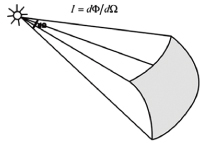 |
 |
Luminous Flux
Luminous Flux is the measure of the perceived power of light and is adjusted to reflect the varying sensitivity of the human eye to different wavelengths of light. The unit of luminous flux is the lumen (lm). One lumen is defined as the luminous flux of light produced by a light source that emits one candela of luminous intensity over a solid angle of one steradian. |
|
||||
Luminous Intensity
Luminous intensity is a measure of the wavelength-weighted power emitted by a light source in a particular direction per unit solid angle, based on the luminosity function, a standardized model of the sensitivity of the human eye. The unit of luminous intensity is the candela (cd), |
|
||||
Illuminance
Illuminance is the total luminous flux incident on a surface, per unit area. It is a measure of the intensity of the incident light, wavelength-weighted by the luminosity function to correlate with human brightness perception. The unit of illuminance is lux (lx). |
|
||||
Luminous Efficacy |
|||||
Color Temperature
Color temperature is a characteristic of visible light that has important applications in lighting, photography, videography, publishing, manufacturing, astrophysics, and other fields. The color temperature of a light source is the temperature of an ideal black-body radiator that radiates light of comparable hue to that of the light source. Color temperature is conventionally stated in the unit of absolute temperature, the kelvin (K). |
|
||||
Color Rendering Index |
|
||||
Luminaire Efficiency |
|||||
Spectrum |
|
||||
Glare |
|||||
Unified Glare Rating |
|||||
Light Intensity Distribution |
|||||
Uniformity of Illumination |
|||||




.jpg)
.jpg)
.jpg)